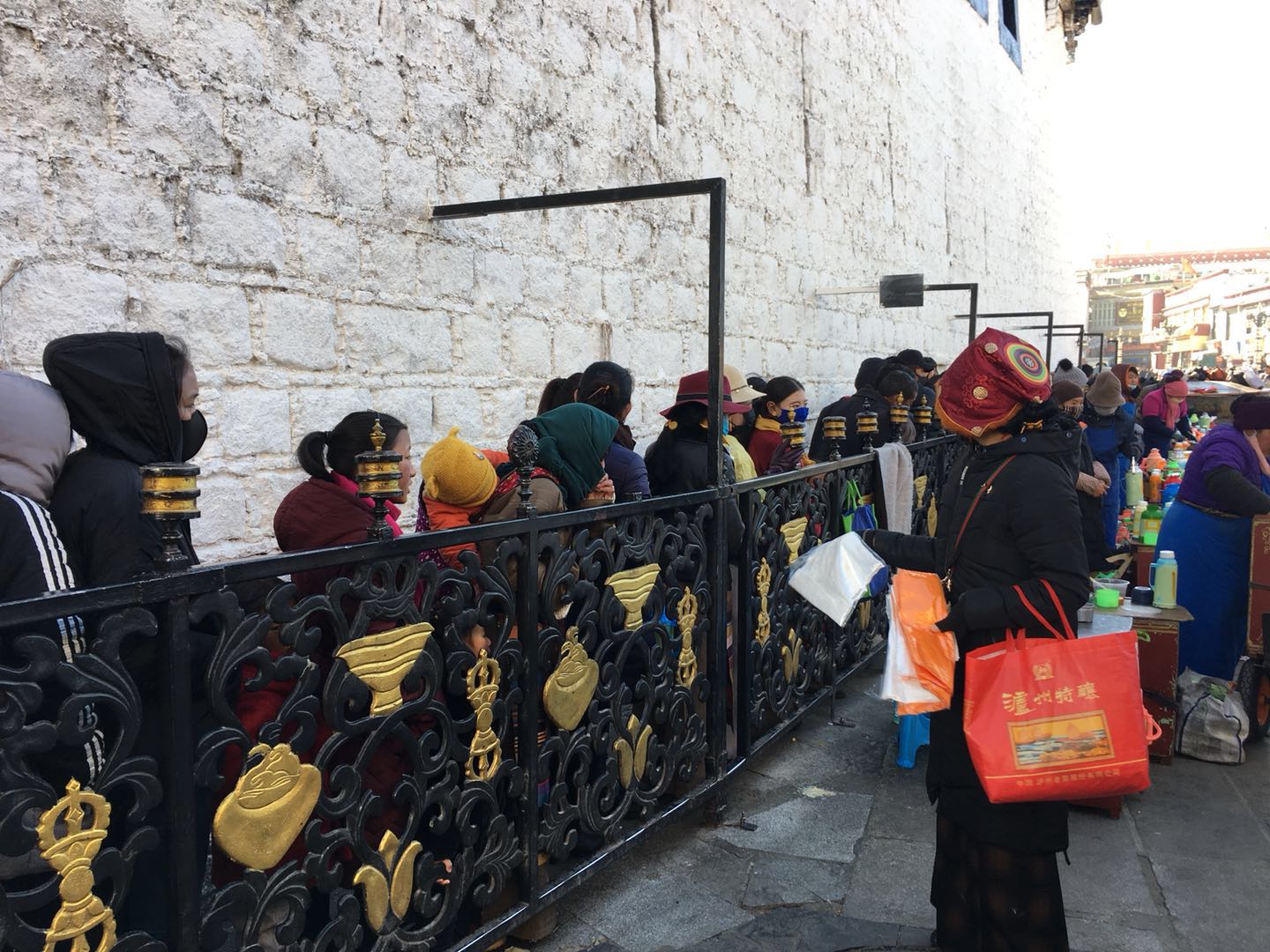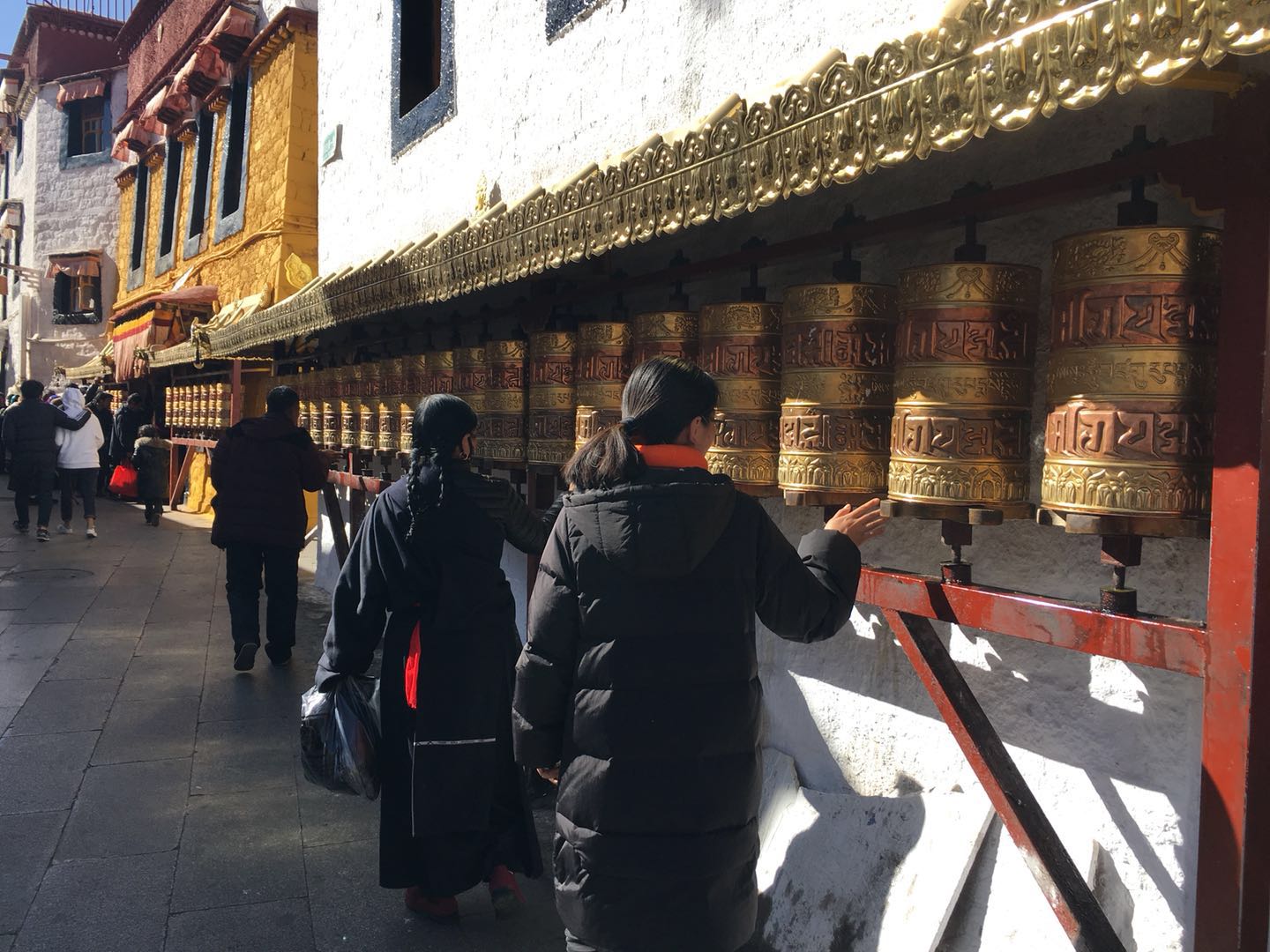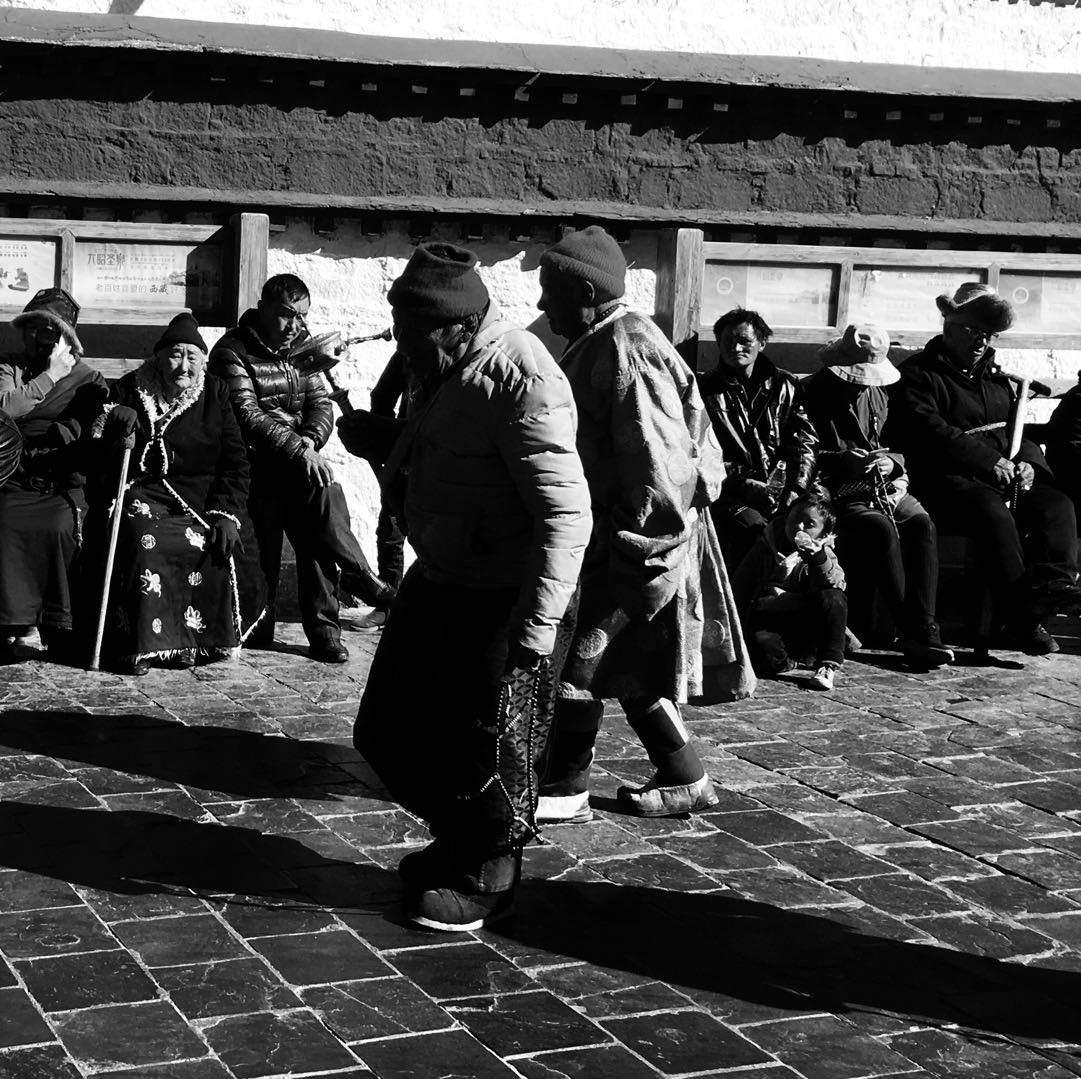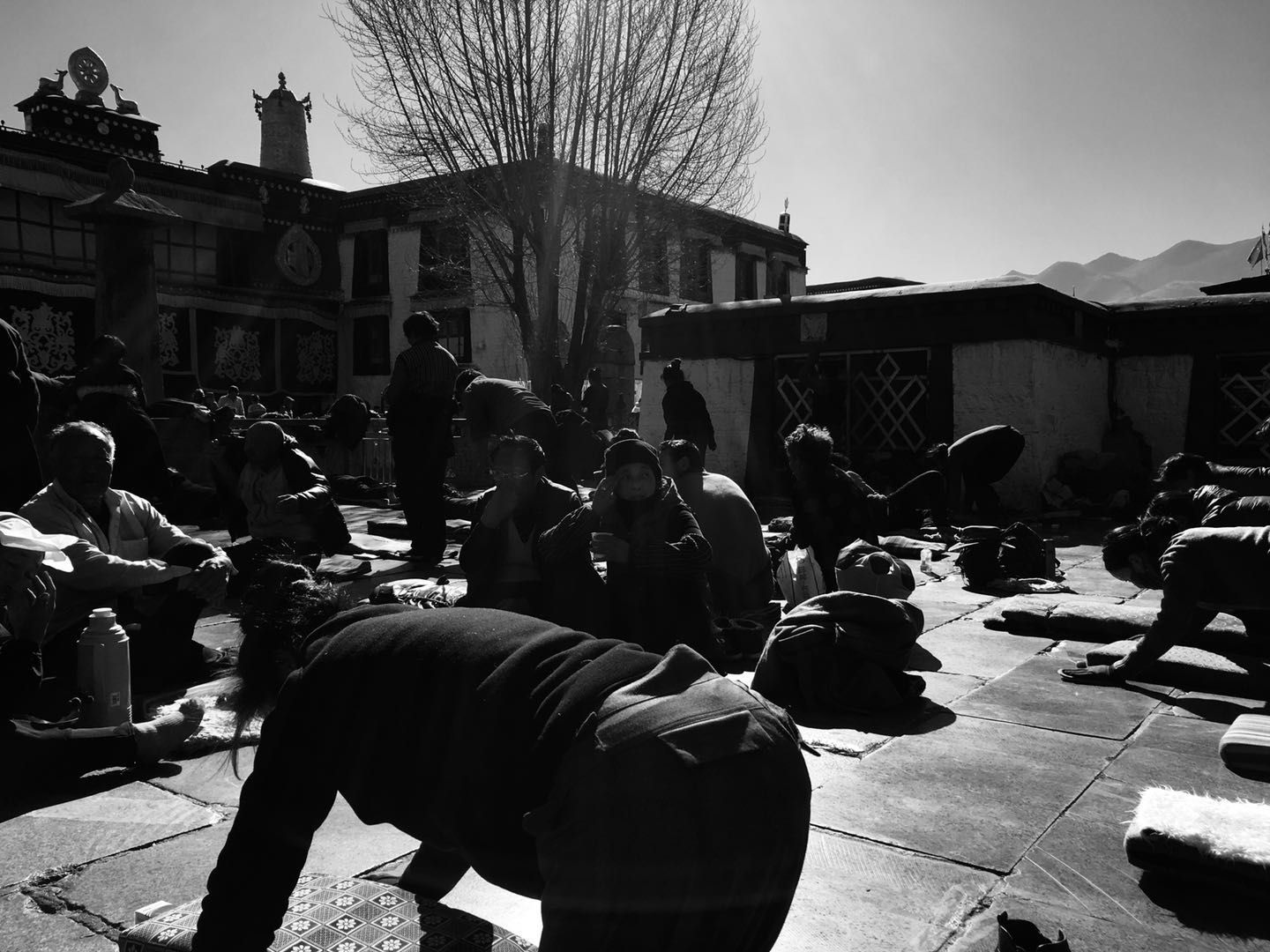Memories of Tibet (20) : The Real Lhasa

On the last day, I went back to Lhasa, and the whole seven days of Ali's journey ended when I stepped out of the door.
Xiao Li, Xiao Wang, ye and I got along for seven days, which made me have three more friends. The four of us booked tickets to leave Lhasa on the same day. We don't have to worry about who will go first and who will go later
Before I left, there was another concern in my heart, that is, Jokhang Temple.
I have forgotten how many times I have stood in the square in front of Jokhang Temple. As usual, the believers are worshipping, and the incense is still around

This time, I caught up with the new tourism preferential policies issued by the Tibetan government. I could enter the Jokhang Temple free of tickets and enjoy direct access from the tourist channel without waiting in line like the Tibetans outside. Looking at the long queue of Tibetans outside the door, although I was a little ashamed, as if I had given a reward without merit, I still had the cheek to break in. I invited a tour guide in Jokhang Temple and began to visit the holy land.
The Jokhang Temple was built in the heyday of the Tibetan Dynasty in the seventh century. It is said that the purpose of its construction is to worship a Buddha statue of mingjiuduoji, the eight year old statue of Sakyamuni. It is said that the Buddha statue was brought from his hometown by Nepalese Chizun princess who was married by the then Tubo zangpsongzangan bu.
According to the frescoes at the entrance of the main hall passage of Jokhang Temple, the temple was originally located in a lake, but with the efforts of Songzanganbu, people and goats worked together to fill it up and build it as a temple. In Tibetan, the name of "goat" is "provoke", and the name of "Earth" is "Sa". In order to commemorate the achievements of white goat, the Buddha Hall was originally named "provoke Sa", later renamed "zulakang" (scripture hall), also known as "juekang" (Buddha Hall), which is fully called "provoke sagaxi Gung zulakang", meaning that the goat carries the earth. The name "Dazhao" is said to have something to do with the "Dazhao Dharma society" which began in the 15th century.
There is a saying among Tibetan people that "first there is Jokhang Temple, then there is Lhasa City". Jokhang Temple has a central position in Lhasa, not only in geographical location, but also in social life. The reason why Lhasa has the reputation of "holy land" is that there are statues of Sakyamuni in Jokhang Temple. Jokhang Temple was originally called rasa (also known as "Raisa"), later Raisa became the name of the city and evolved into the current "Lhasa". After the completion of the Jokhang Temple, it was modified and expanded repeatedly in the yuan, Ming and Qing Dynasties, forming the current scale.
It is worth mentioning that the 12-year-old statue of Sakyamuni brought by Princess Wencheng of Tang Dynasty is enshrined in Jokhang Temple, while the 8-year-old statue was transferred to Xiaozhao temple in the eighth century. According to the records of those Tibetan books, Princess Wencheng, in order to subdue the "gate of evil way", left the statue of Sakyamuni (i.e. the statue of Sakyamuni at the age of 12, the statue of Sakyamuni at the age of 12, the statue of Sakyamuni at the age of 12, and the statue of Sakyamuni at the age of 12) in raomqi (hot die cutting, provoking Mao cutting), and then built Xiaozhao Temple (hot die cutting temple, provoking Mao cutting Temple) in raomqi.
Wu Zetian, the empress of Tang Dynasty, claimed that Maitreya Buddha was reincarnated and Buddhism flourished. So she wanted to ask Tibet for the 12-year-old statue of Sakyamuni, which was taken out by Princess Wencheng. The king of Tibet disagreed. In order to prevent the Tang army from taking away the 12-year-old statue of Sakyamuni, she hid it in the Jokhang Temple, sealed it with mud, and painted the Manjusri statue, so she cheated the Tang army and kept the statue
Turn the first hall clockwise from left to right. There are zongkaba and his eight disciples in it. All of them have made great contributions to the promotion of the Yellow religion. The first Dalai Lama and the first Panchen are among the eight disciples. Among the six major temples of the Yellow religion, Gandan temple was built by zongkaba himself, and zhebong temple, salad temple and zhashlunbu temple were all built by his disciples.
At the corner of the west wall and the north wall stands a white pagoda, which is said to have appeared from the Wotang lake before the construction of the Jokhang Temple. In the first small hall on the south side, there are eight "masters of Oriental pure glass world", a herbalist Buddha. Next to the small hall is the statue of mirarepa, one of the founders of the white religion, with the ear side of the hand. The third Buddha is built in the hall. The second hall is GuanShiYin hall. The local people are very devout in the way of supporting Buddha. In the hall, they often meet some local families to paint gold powder on the face of Avalokitesvara. On the right side of the hall, there are statues of Songzanganbu, Chizun and Princess Wencheng.
In the eyes of the Tibetan people, Songzanganbu and Princess Wencheng became the king of Bodhisattva and later educated the Tibetans. The two princesses are dignified in appearance, among which the typical woman in the Tang Dynasty with high bun in front is Princess Wencheng. At the corner of the south wall and the east wall, there are Zong Kaba and other sects' gurus. The first Buddha Hall in the east wall is wuliangguang Buddha.
Turning the corner of the hall is a pair of murals. The content is a celebration organized by Songzanganbu and the princess in the seventh century. It is the opening ceremony for the completion of the Jokhang Temple. In fact, it is a scene of the traditional sports meeting in the seventh century. Including wrestling, yak dance, mask dance, archery and so on. The mountain on the left side of the mural is Yaowang mountain. On the painting is the original Tibetan medical college. The White Pagoda above is the pagoda on the side of the square in front of Potala Palace. It was the west gate of Lhasa city. On the right side of the mural is the Potala Palace with only two main buildings, that is, the palace built by songzangan.
There are 380 warping tubes around the main hall, one next to the other. It is a must for many devout believers to walk and push the prayer wheel.

After entering the Jokhang Temple from the main gate, you can enter a wide open courtyard in a clockwise direction. It used to be the place of the grand Lhasa praying Dafa meeting "moranchinmo". At that time, tens of thousands of monks from the three mosques of Lhasa gathered here to pray for the happiness of all living beings and social stability. At the same time, they also held activities such as Scripture debate, ghost dispelling and greeting the Maitreya Buddha. The "moranchinmo" began in 1409 ad. the most famous master of Kabbah, in order to commemorate Sakyamuni's great defeat of six kinds of external virtues by the method of divine change, called together monks of various temples and sects to hold a Dharma meeting of blessing and blessing in Jokhang Temple during the first month of the Tibetan calendar. The colonnade wall around the courtyard and the murals on the wall of the transit corridor are called the thousand Buddha Gallery because they are full of thousand Buddha statues. There are more than 4400 square meters of murals in the whole Jokhang Temple.
From the courtyard to the ticket office on the side door, there are stairs leading to the platforms on the second and third floors. The second floor is open only in the morning. The temple of the king of France in Songzanganbu is also on the southwest corner of the second floor. There are statues of Songzanganbu, Princess Wencheng, Princess Chizun of Nepal, Minister ludongzan, etc. they are also early works. Between the second and third floors, there is bandanram Dharma temple, which is the Dharma goddess of Jokhang Temple and the whole Lhasa city. There is a ladder in the northeast corner of the second floor patio, leading to the small door on the third floor, which is the entrance to the golden roof. The third floor of the main hall is usually closed to the outside world, where monks meditate and practice. The four huge golden roofs on the top floor were built in the middle of the 14th century and the 17th century.
Continue to turn right and pass through the night fork hall and Dragon King Hall on both sides. Behind hundreds of lighted butter lamps is the famous "juekang" Buddha Hall. It is not only the main body of Jokhang Temple, but also the essence of the Buddha. The Buddha Hall is a closed courtyard with four floors high and the central hall is the Sutra hall. Tibetan Buddhist believes that Lhasa is the center of the world, and the core of the universe is here. This is the place where the monks of Jokhang Temple chant sutras and practice. From the great scripture hall, you can see the statue of Avalokitesvara with exquisite shape. There are two Buddha statues on both sides, one is lianhuasheng on the left, the other is Qiangba Buddha on the right. The Sutra hall is surrounded by small Buddhist halls. Apart from the Sakyamuni Buddhist hall, which is located in the center, the rooms are not large, but the layout is simple. Sakyamuni hall is the core of Jokhang Temple, which is the ultimate aspiration of pilgrims. The Buddha statue enshrined in this temple is the Buddha statue brought by Princess Wencheng.

A circle of "capsule" around the "juekang" Buddha Hall along the thousand Buddha corridor is satisfactory. Lhasa's main Scripture transfer activities are all centered on the Sakyamuni Buddha of Jokhang Temple. Besides the inner circle, the surrounding area around Jokhang Temple is the "middle circle", namely the "Baguo", that is, the ancient and bustling commercial street Bajiao street. Around the Jokhang Temple, Yaowang mountain, potala palace and Xiaozhao temple, it is the "outer circle", that is, the "forest outline", which has surrounded the city of Lhasa for the most part.

In Lhasa, Tibetans like to call the Bajiao Street area dominated by Jokhang Temple "Lhasa". In Tibetan, it means Buddha land. Everywhere, worshipers kowtow at the gate of Jokhang Temple. The scene is moving. It can be seen that the position of Jokhang Temple in Lhasa People's mind is high. Therefore, in Tibetan people's mind, the only place that can be called "Lhasa" is Jokhang Temple, not Lhasa city and bubo Dala palace.
Leaving Jokhang Temple, my trip to Tibet is just the end!
Recalling the journey of more than 20 days, there are too many excitement, happiness, regret and reluctant to give up. Every person and every emotion generated in the journey are deeply remembered in my heart. I only saw a tiny corner of Ali area, which has the deepest influence on me. This unwillingness makes me find it back And then there's Gung rinpochi, who's thinking. At the right time, I will appear in his arms
Stepping on the train to go home, I stare at the hot land just familiar with through the window, as if I want to run away from home again. Although I am reluctant to give up, I can only accept the departure I have to face.
I waved, "goodbye, Tibet in the sky!"
- Link : https://www.zdyla.com/en/post/about-xizang-20.html
- Copyright Notice : Unless otherwise stated, please contact the author for authorization and indicate the source!

